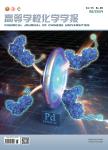α,α-二乙酰基二苄硫缩烯酮的碱催化脱乙酰基反应及缩合反应机理研究
Studies on the Mechanism of Deacylation and Condensation Reactions of α,α-Diacetyl Ketene Dibenzylthioacetal作者机构:东北师范大学化学学院 长春教育学院化学系长春130061
出 版 物:《高等学校化学学报》 (Chemical Journal of Chinese Universities)
年 卷 期:2004年第25卷第5期
页 面:877-879页
核心收录:
学科分类:081704[工学-应用化学] 07[理学] 08[工学] 0817[工学-化学工程与技术] 070303[理学-有机化学] 0703[理学-化学]
基 金:国家自然科学基金 (批准号 :2 0 2 72 0 0 8) 教育部科学技术研究重点项目基金(批准号 :0 3 0 5 9)资助
主 题:α,α-二乙酰基二苄硫缩烯酮 碱催化 脱乙酰基反应 缩合反应 反应机理
摘 要:The behavior of α,α-diacetyl ketene dibenzylthioacetal 1a under basic conditions was studied. Catalyzed by steric hindered base as t-BuONa(in t-BuOH), α-acetyl ketene dibenzylthioacetal 2a could be obtained in 98% yield within 3 min via deacylation of 1a. Assisted by t-BuONa(in t-BuOH), α-cinnamoyl ketene dibenzylthioacetals were produced in high yields by reacting both 1a and 2a with arylaldehydes; whereas, under the same conditions, the corresponding α,α-dicinnamoyl ketene dibenzylthioacetals 4 were formed when furan-2-carbaldehyde and thiophene-2-carbaldehyde were used as the electrophiles. These evidences support the proposed mechanism that, catalyzed by t-BuONa (in t-BuOH), the reaction of 1a with arylaldehydes may normally proceed via a sequential deacylation-condensation process and the formation of double condensation products 4 may be due to the higher activity of furan-2-carbaldehyde and thiophene-2-carbaldehyde under the selected reaction conditions.



